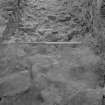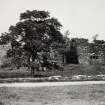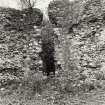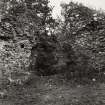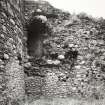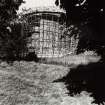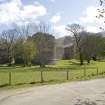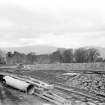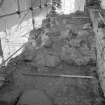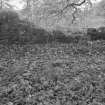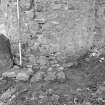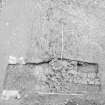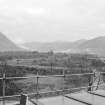Following the launch of trove.scot in February 2025 we are now planning the retiral of some of our webservices. Canmore will be switched off on 24th June 2025. Information about the closure can be found on the HES website: Retiral of HES web services | Historic Environment Scotland
Inverlochy Castle
Castle (Medieval)
Site Name Inverlochy Castle
Classification Castle (Medieval)
Alternative Name(s) Fort William, Old Inverlochy Castle; Cumyn's Tower; River Lochy; Castle Pool
Canmore ID 23701
Site Number NN17NW 1
NGR NN 12039 75442
Datum OSGB36 - NGR
Permalink http://canmore.org.uk/site/23701
First 100 images shown. See the Collections panel (below) for a link to all digital images.
- Council Highland
- Parish Kilmonivaig
- Former Region Highland
- Former District Lochaber
- Former County Inverness-shire
Inverlochy Castle, c.12 70-80 Quadrangular castle of enclosure at the mouth of the River Lochy, remarkable for having remained largely unaltered since before the Wars of Independence. It is said to have been built by John Comyn, Lord of Badenoch and Lochaber and supporter of Edward I. Recently consolidated, the ruin was strategically sited at the entrance to the Great Glen, its bold 13th century form plain to see. Formidable rubble walls, unpierced by openings or evidence of connected buildings, surround a courtyard with corner towers, each containing a mural stair. The largest of these - Comyn's Tower, on the north - west angle - was the donjon, with a garderobe opening off it on the 2nd floor. The principal entrance is on the south, a watergate on the north. Both had portcullises - evidence of these, and of the ditches which surrounded the castle on three sides, fed by the waters of the Lochy from its 4th side, can still be defined. Following Robert the Bruce's succession to the crown in 1306, the Comyns were ousted and the castle fell into decay. After the fall of the Lordship of the Isles, Inverlochy was repaired by the 2nd Earl of Huntly, who garrisoned it in 1505 and received a charter from James IV. Lord Abinger attempted repairs c.1905, restoring loops and battlements.
The tradition that a Pictish castle was succeeded by an important early settlement at Inverlochy is supported by archaeological evidence of earlier structures on the site. According to Boece (1526), a 'city ... much frequented with merchants of France and Spain' was destroyed here by Vikings. Two important battles took place at Inverlochy: in 1431, when the clansmen of the Lords of the Isles defeated James I's much larger army, and in 1645, when Argyll's Covenanters were slaughtered by Montrose's royalist highlanders.
Taken from "Western Seaboard: An Illustrated Architectural Guide", by Mary Miers, 2008. Published by the Rutland Press http://www.rias.org.uk
NN17NW 1 12039 75442
(NN 1203 7544) Inverlochy Castle (NR) (in ruins)
Cumyn's Tower (NR)
OS 6" map, Inverness-shire, 2nd ed., (1904).
Location formerly entered as NN 1203 7544.
Not to be confused with Inverlochy Castle Hotel (NN 13831 76705), for which see NN17NW 15.00.
Inverlochy Castle, of c. 1270-1280 date, is a simple square courtyard contained by four high curtain walls. A massive round tower projects boldly from each corner, one, the donjon (Comyn's Tower) (D MacGibbon and T Ross 1887), being larger than the others.
The enclosure so formed has two entrances, plain pointed arch openings, without foreworks or gatehouse, through the centre of two opposite sides. The entance is but a doorway in which hung a heavy two-leaved door secured by a draw-bar and protected by a portcullis. The curtain is surrounded by a wide ditch and outer bank concentrically disposed about it. The ditch is silted but clearly definable round 3 sides. the fourth side confronting the River Lochy, was not ditched. The entrance through this side was the water-gate; before it there would no doubt be a channel from the river and a small harbour or dock. Water from the river was introduced to the ditch round the other 3 sides.
The curtain and towers stand to a height of about 30'. (S Cruden 1960) (Toy [S Toy 1966] describes and plans a barmkin here. Not only is this a 'folly' but his description and plan of it are in error).
There is no proper history for this castle but tradition has it that it was built by the Comyns, Lords of Lochaber and Badenoch from about 1080 to the accession of Bruce in 1306. In 1505 its ruined site was granted to George, second Earl of Huntly on condition he built 'a towerand strength and Barmekyn' to serve as a Royalist garrison.
D MacGibbon and T Ross 1887; S Cruden 1960; S Toy 1966.
Inverlochy Castle : as described by Cruden (S Cruden 1960).
Visited by OS (CFW), 19 July 1961.
Now under the guardianship of the MOPBW. Otherwise, no change.
Visited by OS (NKB), 11 May 1970.
The principal area of excavation was the NE tower where rubble up to 1m deep overlay the original floor of roughly levelled construction debris. The tower had been built against disturbed soils which included skeleton remains, believed to be human. This indicates an occupation of the site earlier than that of the extant castle's construction.
Adjacent to the tower and within the courtyard a 5m by 4m trench was opened. Nothing in this trench substantiated the theory that there had been a range of timber buildings in the E of the courtyard although a line of squared sockets along the entire length of the E curtain, at first floor level, would suggest that such buildings had once existed there.
Access to the living quarters of the NE tower was probably gained via the first floor and in the N curtain was an entrance way (later blocked) that may have coincided with this level. A sandstone threshold in the basement exhibited almost no sign of wear suggesting this to have been a little-used room.
A cobbled floor of good construction was partially uncovered outwith and adjacent to the N curtain and the NE tower. This was of late date and may have belonged to a building erected by the Invergarry Ironworks Company in the second quarter of the 18th century.
J Lewis 1983.
The principal area of excavation in 1989 consisted of the interior of the SW tower and a 3m wide trench between the tower and the castle's S entrance. In addition, the removal of vegetation and losse debris provided an opportunity to examine the wall-head of the somewhat complex W curtain wall.
South West Tower and Courtyard
Both areas were covered with humic soils and rubble, up to 1.4m deep, derived from masonry collapse and, on the evidence of very modern artefacts, perhaps also from recent, unauthorised activities within the monument. In many places these deposits lay directly upon tightly-folded and fractured schistose bedrock, there being no surviving trace of a floor surface or any other occupation horizon.
Where the outcrops of bedrock were high, the castle walls were built directly upon it; otherwise the masonry was laid on foundations of mortar-bonded granite rubble or, particularly within the SW tower, simply upon buried topsoil.
Prior to excavation, the ground level adjacent to the S curtain was considerably higher than at any other within the courtyard, giving rise to speculation of an internal timber range, similar to that against the E curtain. Excavation, however, demonstrated that the raised platform was simply the result of high outcropping of bedrock.
West Curtain Wall
At wall-head level, the 3m-wide curtain comprised three main elements: 1. an inner skin of rubble masonry, 0.55m to 0.6m wide and 0.8m high;
2. a 0.55m to 0.6m outer parapet, which had been remodelled by the addition of battlements in the 19th century.
3. the intervening wall-walk.
There were neither paving slabs over the walk-way's mortared rubble surface nor were there any drains to remove surface water from it, suggesting the wall-head may have been roofed.
Four steps descended from the level of the SW tower's upper storey to that of the main section of the wall-head. Three further steps led down to the top floor (possible guard chamber) of the NW tower and, independently, to the wall-walk atop the N curtain.
Two deep beam sockets and a single projecting corbel, adjacent to the donjon, may have been associated with a garderobe overhanging the ditch to the W of the castle. Another socket, further S, was for a beam projecting into the courtyard.
Sponsor SDD HBM
J Lewis 1989.
The wallhead of the E section of the S curtain was cleared of debris by Scotia Archaeology Limited prior to the consolidation of its masonry. Midway along this stretch of wall, below a thin skim of loose debris, was a block of compact, well mortared rubble, almost 4m long and covering the width of the wall to a height of 0.8m. Although there were no visible surviving impressions of treads or risers within this rubble, this material is tentatively interpreted as the base for a short flight of steps which perhaps led into an upper storey of a building set against the inside face of the curtain wall.
Sponsor: Historic Scotland.
J Lewis 1994c.
NN 120 754 Exploratory excavations were carried out by Scotia Archaeology Limited at several locations within and adjacent to the 13th century castle.
A small, L-shaped mound in the E corner of the castle courtyard proved to be of relatively recent origin.
Work outside the main (SE) entrance to the castle revealed that the low terrace against the curtain wall was bounded by a wall which abuts and presumably post-dates the putative barbican which survives to a height of at least 1.0m.
Several trenches were excavated against the outer enclosure wall which encircles the castle. It is thought that parts of the wall, which has a maximum width of only 0.5m, were once field boundaries and that its SE side, including its turrets, are of 19th century date.
Sponsor: Historic Scotland.
H Smith 1995.
NN 120 754 A trench, measuring approximately 8m N-S by 3m wide, was excavated by Scotia Archaeology Ltd within and adjacent to the N entrance (the seagate) to the castle. This revealed what may have been a metalled surface through the gateway; and, abutting the outer face of the N curtain, the fragmentary foundations of a substantial wall, perhaps an element of a structure similar to the barbican at the S entrance to the castle (see Discovery and Excavation, Scotland 1995, 41).
In addition, a watching brief was undertaken during the excavation, by Historic Scotland's DEL squad, of drainage trenches from the W curtain wall and NW (donjon) tower, through the seagate and beyond the N limits of the castle. In one of those trenches was found the lower part of an articulated human skeleton, perhaps dating from the second battle of Inverlochy in 1644. Another drainage trench exposed the foundations of what appeared to be the S wall of a range, built against the W side of the N curtain.
Sponsor: Historic Scotland.
H Smith 1996.
NN 120 754 A landscape assessment was made of an area of derelict land immediately SE of Inverlochy Castle, near Fort William. Nothing of significance was noted.
Sponsor: Historic Scotland
P Sharman and A Radley 1999
NN 120 754 A watching brief was undertaken in February 2000 in a Scheduled area to the SE of Inverlochy Castle (NMRS NN17NW 1) during the excavation of holes and drainage trenches for a septic tank and soakaway. Nothing of archaeological significance was noted.
Sponsor: Historic Scotland
P Sharman 2000.
(Scheduled as Inverlochy Castle).
Information from Historic Scotland, scheduling document dated 17 December 2010.
Inverlochy Castle [NAT]
OS (GIS) MasterMap, January 2011.
Photographic Record (1928)
Archaeological Evaluation (14 January 1999 - 29 January 1999)
A landscape assessment was made of an area of derelict land immediately SE of Inverlochy Castle, near Fort William. Nothing of significance was noted.
Sponsor: Historic Scotland
P Sharman and A Radley
Watching Brief (21 February 2000)
Kirkdale Archaeology undertook a watching brief for Historic Scotland in a scheduled area to the SE of Inverlochy Castle by Fort William, Highland Region (NGR NN 120 754). The work was required by the excavation of holes and drainage trenches for a septic tank and soakaway. Immediately below the topsoil, undisturbed post-glacial raised beach gravel deposits overlying a C-horizon subsoil of gleyed clay and stone were revealed. Nothing of archaeological significance was noted.
Sponsor: Historic Scotland
P Sharman 2000
Kirkdale Archaeology
Photographic Record (20 April 2007)
Metal Detector Survey (14 December 2016)
Alder Archaeology Ltd was contracted by John Lewis of Scotia Archaeology Ltd to undertake an archaeological metal detecting survey, Alder site code FW03, on the proposed line of an electricity cable, earth wire and new pole, for Scottish and Southern Electricity.
The site is a field centred on NN 12155 75392 which forms part of the ground upon which the battles of as Inverlochy I (1431) and Inverlochy II (1645) were fought, and it was hoped to find artefacts from these encounters. The ground surveyed is to the S of the former Inverlochy Mains Farm building and is currently in use by Stramash as an outdoor nursery for 2 to 5-year-old children. The site contains two yurts and many small lightweight wooden structures for playing/learning.
The electricity pole will be located at NGR NN 12143 75346, approximately 100m to the SE of Old Inverlochy Castle. The electric cable proposed route extends 77m to NNE of the pole site while the earth wire route will extend 63m to the E of the pole (total length 140m). A corridor 5m wide was surveyed over this route. The work was carried out on 14th December 2016 in very wet conditions. The metal detecting finds were all modern; coins, cans, nails, metal tube, bolt, toy cars, etc. Nothing that could be related to the 15th and 17th century battles was recovered. It was concluded that no metal artefacts dating from the conflicts were to be found along the 5m wide corridor surveyed. Further archaeological work in the form of a watching brief will be undertaken during the groundworks for the installation of the electricity supply.
Information from Alder Archaeology Ltd
























































































































